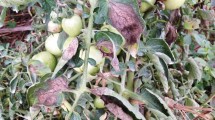Summary
The effects of destruxin B, a host-specific toxin of Alternaria brassicae that causes black spot disease in oilseed brassicas, were studied on in vitro pollen germination and pollen-tube growth of Brassica campestris var “brown sarson”, B. juncea, B. napus cvs “Westar” and “Cresor”, B. nigra and Sinapis alba. Pollen grains of B. nigra, B. juncea and B. campestris were the most sensitive and those of S. alba the least sensitive to the toxin. Effects of the toxin were also studied on the leaves of these species, and the degree of sensitivity of leaves of different species was comparable to that of their pollen grains. The results on the responses of pollen grains as well as leaves to the toxin are in agreement with the degree of susceptibility/resistance of these species to A. brassicae reported in the literature, indicating that the genes imparting susceptibility/restistance are expressed in the pollen, a prerequisite for pollen selection. Results are also presented which show that the toxin fed to the cut end of isolated inflorescence axis is readily taken up by the developing pollen and results in the inhibition of germination of susceptible pollen. This technique offers a simple and effective method for application of selection pressure to eliminate pollen grains susceptible to the toxin from effecting fertilization.
Similar content being viewed by others
References
Bains PS (1989) Purification, chemical characterization, host specificity, bioassay, mode of action, and herbicidal use of the toxin produced by Alternaria brassicae. PhD thesis, University of Alberta, Edmonton, Canada
Bains PS, Tewari JP (1987) Purification, chemical characterization and host specificity of the toxin produced by Alternaria brassicae. Physiol Mol Plant Pathol 30:259–271
Bino RJ, Franken J, Witsenboer HMA, Hille J, Dons JJM (1988) Effects of Alternaria alternata f. sp. lycopersici toxins on pollen. Theor Appl Genet 76:204–208
Buchwaldt L, Jensen JS (1991) HPLC purification of destruxins produced by Alternaria brassicae in culture and leaves of Brassica napus. Phytochemistry 30:2311–2316
Chevre AM, Eber F, Brun H, Plessis J, Primard C, Renard M (1991) Cytogenetic studies of Brassica napus Sinapis alba hybrids from ovary culture and protoplast fusion. Attempts to introduce Alternaria resistance into rapeseed. In: McGregor DI (ed) Proc GCIRC 8th Int Rapeseed Congr, vol 2. Saskatoon, pp 346–351
Degenhardt K, Skoropad WP, Kondra ZP (1974) Effects of Alternaria blackspot on yield, oil content and protein content of rapeseed. Can J Plant Sci 54:795–799
Evans DE, Singh MB, Knox RB (1990) Pollen development: applications in biotechnology. In: Blackmore S, Knox RB (eds) Microspores: evolution and ontogeny. Academic Press, London San Diego, pp 309–338
Goodman RM, Hauptli H, Crossway A, Knauf VC (1987) Gene transfer in crop improvement. Science 236:48–54
Gundimeda HR, Prakash S, Shivanna KR (1992) Intergeneric hybridization between Enarthrocarpus lyratus, a wild species and crop brassicas. Theor Appl Genet 83:655–662
Heslop-Harrison J, Heslop-Harrison Y (1970) Evaluation of pollen viability by induced fluorescence: intracellular hydrolysis of fluorescein diacetate. Stain Technol 45:115–120
Hodgkin T (1987) A procedure suitable for in vitro pollen selection in Brassica oleracea. Euphytica 36:153–159
Hodgkin T (1990) In vitro pollen selection in Brassica napus L. for resistance to phytotoxic compounds from Alternaria brassicicola (Schw.) Wilts. Sex Plant Reprod 3:116–120
Hodgkin T, Lyon GD (1986) The effect of Brassica oleracea stigma extract on the germination of B. oleracea pollen in a thin-layer Chromatographic bioassay. J Exp Bot 37:406–411
Hormaza JI, Herrero M (1992) Pollen selection. Theor Appl Genet 83:663–672
Kolte SJ (1985) Diseases of annual edible oilseed crops. Volume II: Rapeseed-mustard and sesame diseases. CRC Press, Boca Raton, Fla.
Kolte SJ (1991) Diseases. In: Chopra VL, Prakash S (eds) Oilseed brassicas in Indian agriculture, Vikas Publ House, New Delhi, pp 198–208
Laughnan JR, Gabay SJ (1973) Reaction of germinating maize pollen to Helminthosporium maydis pathotoxins. Crop Sci 13:681–684
Linskens HF, Esser K (1957) Über eine spezifische Anfärbung der Pollenschläuche im Griffel und die Zahl der Kallosepfropfen nach Selbstung und Fremdung. Naturwissenschaften 44:16
Mulcahy DL (1983) Manipulation of gametopyhtic population. In: Lange L, Zeven AC, Hogenboom NG (eds) Efficiency of plant breeding (Proc 10th Congr EUCARPIA). PUDOC, Wageningen, The Netherlands, pp 167–175
Ottaviano E, Mulcahy DL (1989) Genetics of angiosperm pollen. Adv Genet 26:1–64
Petrie GA (1975) Diseases of rapeseed and mustard. In: Hara-piak JT (ed) Oilseed and pulse crops in Western Canada. Western Co-operative Fertilizers Ltd, Calgary, pp 319–413
Polowick PL, Sawhney VK (1991) In vitro floral development of oilseed rape (Brassica napus L.): the effects of pH and plant growth regulators. J Exp Bot 42:1583–1588
Ripley Van L, Arnison PG (1990) Hybridization of Sinapis alba L. and Brassica napus L. via embryo rescue. Plant Breed 104:26–33
Shivanna KR (1991) Incompatibility. In: Chopra VL, Prakash S (eds) Oilseed brassicas in Indian agriculture. Vikas Publ House, New Delhi, pp 117–137
Shivanna KR, Rangaswamy NS (1992) Pollen biology: a laboratory manual. Springer, Berlin Heidelberg New York
Vasil IK (1990) The realities and challenges of plant biotechnology. Biotechnology 8:296–301
Author information
Authors and Affiliations
Additional information
Communicated by H.F. Linskens
Rights and permissions
About this article
Cite this article
Shivanna, K.R., Sawhney, V.K. Pollen selection for Alternaria resistance in oilseed brassicas: responses of pollen grains and leaves to a toxin of A. brassicae . Theoret. Appl. Genetics 86, 339–344 (1993). https://doi.org/10.1007/BF00222099
Received:
Accepted:
Issue Date:
DOI: https://doi.org/10.1007/BF00222099




